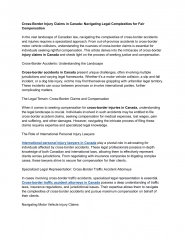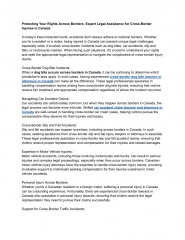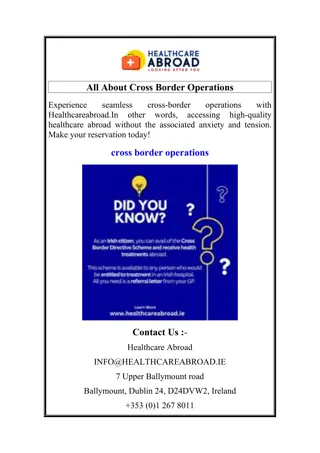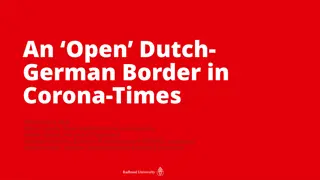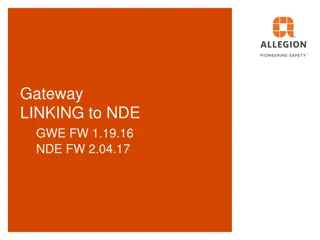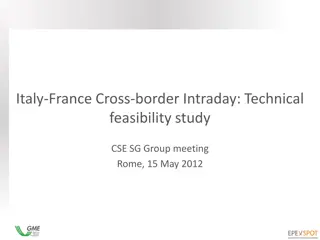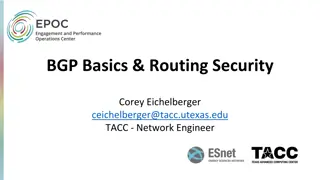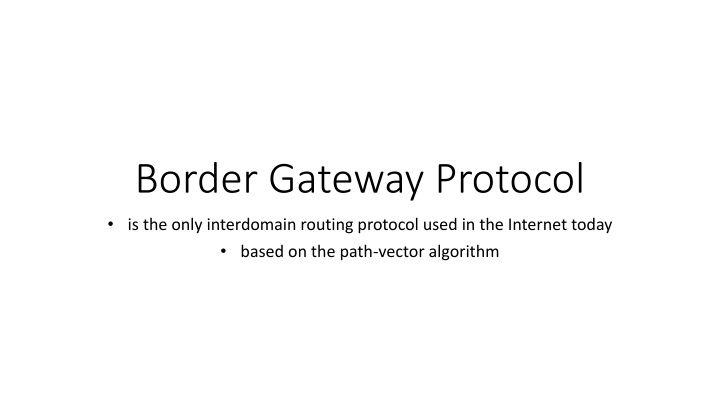
Best Practices for Border Gateway Protocol (BGP) Implementation
Explore the operational aspects of Border Gateway Protocol (BGP) in interdomain routing. Learn about the variations of BGP, external BGP (eBGP) and internal BGP (iBGP), BGP message types, path attributes, and BGP peer operations. Understand how BGP routers establish sessions within Autonomous Systems (AS) and exchange route information to optimize network paths efficiently.
Download Presentation

Please find below an Image/Link to download the presentation.
The content on the website is provided AS IS for your information and personal use only. It may not be sold, licensed, or shared on other websites without obtaining consent from the author. If you encounter any issues during the download, it is possible that the publisher has removed the file from their server.
You are allowed to download the files provided on this website for personal or commercial use, subject to the condition that they are used lawfully. All files are the property of their respective owners.
The content on the website is provided AS IS for your information and personal use only. It may not be sold, licensed, or shared on other websites without obtaining consent from the author.
E N D
Presentation Transcript
Border Gateway Protocol is the only interdomain routing protocol used in the Internet today based on the path-vector algorithm
Each router in each AS knows how to reach a network that is in its own AS, but it does not know how to reach a network in another AS. First install a variation of BGP4, called external BGP (eBGP), on each border router install the second variation of BGP, called internal BGP (iBGP), on all routers
Operation of External BGP BGP protocol is a kind of point-to-point protocol. The two routers that run the BGP processes are called BGP peers or BGP speakerscreate.They create TCP connection using the well-known port 179. Extrenal BGP speakers in our example are:R1-R5, R2-R6, and R4-R9 Each logical connection in BGP peersis referred to as a session.
Operation of Internal BGP (iBGP) it creates a session between any possible pair of routers inside an autonomous system if an AS has only one router, there cannot be an iBGP session. if there are n routers in an autonomous system, there should be [n (n 1) / 2] iBGP sessions in that autonomous system (a fully connected mesh)
Finalized BGP path tables
Messages BGP uses four types of messages for communication between the BGP speakers across the ASs and inside an AS: Open Message. To create a neighborhood relationship, a router running BGP opens a TCP connection with a neighbor and sends an open messageation Update Message. The update message is the heart of the BGP protocol. It is used by a router to withdraw destinations that have been advertised previously, to announce a route to a new destination, or both Keepalive Message. The BGP peers that are running exchange keepalive messages regularly (before their hold time expires) to tell each other that they are alive. Notification. A notification message is sent by a router whenever an error condition is detected or a router wants to close the session
Path Attributes BGPuses BGP Path Attributes to determine the Best Path to a destination. BGP Path Attributes divide into two groups. These classes are Well-Known and Optional path attributes. These two groups divide also into two subgroups again. . A well-known attribute must be recognized by all routers; an optional attribute does not. A well-known attribute can be mandatory, which means that it must be present in any BGP update message, or discretionary, which means it does not have to be. An optional attribute can be either transitive, which means it can pass to the next AS, or intransitive, which means it cannot
The first byte in each attribute defines the four attribute flags The next byte defines the type of attributes assigned by ICANN The attribute value length defines the length ofthe attribute value field
Attribute Types ORIGIN (type 1). This is a well-known mandatory attribute, which defines the source of the routing information. AS-PATH (type 2). This is a well-known mandatory attribute, which defines the list of autonomous systems through which the destination can be reached. NEXT-HOP (type 3). This is a well-known mandatory attribute, which defines the next router to which the data packet should be forwarded. MULT-EXIT-DISC (type 4). The multiple-exit discriminator is an optional non transitive attribute, which discriminates among multiple exit paths to a destination. LOCAL-PREF (type 5). The local preference attribute is a well-known discretionary attribute. It is normally set by the administrator, based on the organization policy. The routes the administrator prefers are given a higher local preference value


